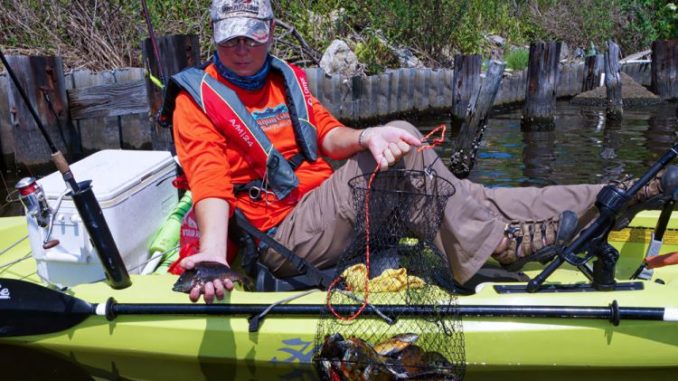
Get back to the basics and target bream in your ‘yak
Many kayak anglers dream of catching giant fish from their small plastic boats. However, going in the completely opposite direction can be even more fun. Imagine catching scores of tiny, delicious fish — using nothing more than worms and a cane pole, or lightweight spinning gear. And kayaks are a great platform for pursuing these colorful, hard-fighting fish that can be found in all but the extreme coastal areas of the state.
“It’s the gateway drug,” said Robyn Bordelon, on a recent kayak trip specifically targeting bream. “I remember when I was a kid at my grandparents’ camp. I’d be the first one up each morning catching bream off the dock.”
True enough.
For a vast majority of Louisiana fishermen, some species of panfish is likely their first fish — and the one that got them addicted to fishing. However, for many, it has also become a lost art as they moved on to bigger and more glamorous species.
Bordelon found herself lamenting how long it had been since she last caught a perch, but the returning memories were certainly welcomed.
Perhaps it’s the nostalgia, but kayak anglers turning back the clock to those simple days of minimal gear are finding joy in getting back to basics.
“A box of worms and a couple of cane poles are all you need to have a great time,” said James Kellum. “I take my son along in the kayak and we both have a blast catching perch (bluegill).”
While a bamboo cane pole works just fine, Kellum prefers inexpensive, retractable fiberglass models.
“These poles are only about 3 feet long when retracted and fit easily in the kayak. They are strong and easy to rig,” Kellum said.
A long-shank bream hook, a small split-shot weight and an adjustable cork are all the tackle that’s needed. Just thread half a small live worm onto the hook and you’re all set.
Kellum starts off with the bait about 12 inches under the cork and adjusts the depth as conditions dictate.
“It shouldn’t take more than a minute or two to get a bite if the fish are there. I like to fish docks or pilings where the fish hideout in the shadows. We usually catch several in one spot and then just move a kayak length or two to the next,” he said.
In addition to worms, grass shrimp and crickets, tiny pieces of fresh shrimp also work well.
For those that prefer tricking fish on artificial lures, baby spinnerbaits like a 1/16-ounce Beetle Spin can’t be beat. Of course, you’ll need a lightweight rod-and-reel combo to cast such tiny lures. Four- to 6-pound line is about the heaviest you want to go, and that still gives a little working room for the stray bass that occasionally will be hooked. Catching a hand-sized bluegill on such light equipment is still an epic battle.
Lure color can definitely make a difference. Have a good selection of colors and extra tails on hand. If fishing with more than one person, have each try a different color to see which one is getting better results. Even if you are catching on one color, a change may produce even more fish. And remember the hot color last week may be totally different for your trip.
Bream are often seen gathered in small groups around a piling, hovering over a rock or sitting next to a stump. Cover is the key. Repeated casts at the same structure can mean multiple fish caught.
The simplicity of catching panfish is amplified in the kayak, without being confined to one spot sitting on a dock or along the bank. The freedom to quietly move from spot to spot offers a change of scenery and access to many prime areas.
Bream fishing really is a minimalist pursuit. A small tackle box, a stringer, rag and a hook remover are all that’s necessary. So leave the depth finder and landing net at home.
These fish have small mouths so it’s best to carry a needle-nose pliers rather than a regular fishing pliers or hook-out. Even better, a small pair of stainless steel locking hemostats can be clamped to your shirt for ready availability and easy removal of hooks from even the tiniest fish.
Getting back to chasing panfish brings a flood of great memories and some unexpected excitement. You’ll find yourself hooting and hollering with each hookup, as if you’ve just latched onto a marlin.
Yes, it still is just that much fun.


